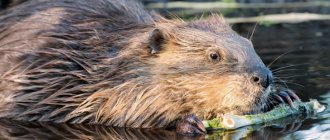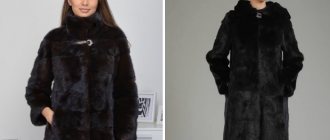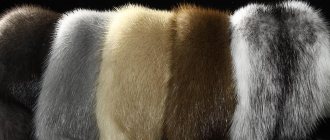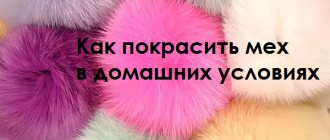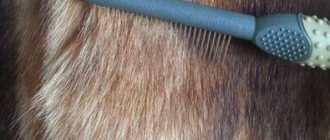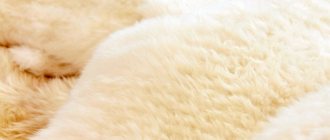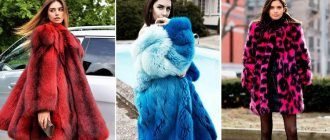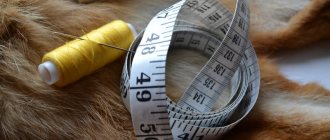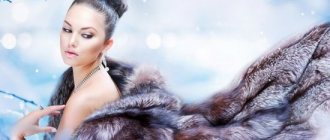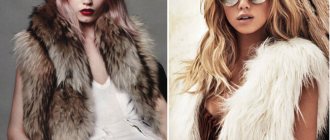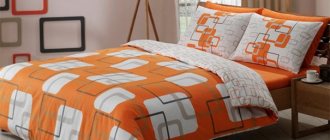How to distinguish mink fur from marmot fur: signs of difference, recommendations for selection
In order to earn as much as possible and achieve maximum personal gain, unscrupulous sellers cut the fur, dye it, apply chemical methods, just to achieve an imitation of more noble furs.
Tips and recommendations (differences between a marmot and a mink):
- Wearability is the main difference between mink and no other fur can boast of such qualities. The second feature is grace.
- It is believed that the easiest way to “recognize” a mink is to run your hand across the fur coat “against the grain.” If the fur is very pleasant and soft, but at the same time elastic and easily returns to its original position, it is natural and 100% mink.
- The same cannot be said about marmot fur - it has more elasticity and is not as flexible as mink. This is why the groundhog's pile becomes shaggy, itchy and even breaks.
- A noticeable difference between a marmot and a mink is its uneven hair length (one hair is longer, the other is shorter).
- Often a marmot is sheared and passed off as a mink, but such a fur coat is easy to distinguish, because the marmot’s fur must first be dyed for this, which means it will have a bluish or purple cast.
- A mink always shines beautifully; a marmot may not shine at all in the sun.
Mink (left) and marmot fur coat (right)
Durability of marmot clothing
If a marmot “survives” being faked as a mink, then it is short-lived. Any natural fur without guard hairs will not last long. Moreover, it is painted. The guard hair is a reliable protection of the fur from moisture and pollution, while the underfur is very sensitive to such influences. Due to the disruption of the structure of the inner layer, the hair follicles are weakened and so on. Even the slightest wetness or contamination greatly shortens the already short service life of such products.
If we consider the solid fur of a marmot, with guard hair, then it is more similar to nutria fur: hard guard and soft cottony underfur. In some areas, hats made from this fur are popular. It is warm and durable, although not fashionable.
Once, a client of the online store PukupkaLux said: “How many different jackets and coats I tried on, I couldn’t find anything better than a marmot fur coat for every day. Of course, in my wardrobe there are several simply amazing down jackets, which I also enjoy wearing, but not to work. The thing is that I work in a serious government agency and, in connection with this, I cannot afford to show up to work in a down jacket, no matter how good it is. That’s exactly why I wear a marmot fur coat, because it looks good and is relatively cheap, I don’t mind wearing it every day.”
Which fur coat to choose, where and how to wear it is your choice. Focus on your rhythm of life, habits and needs and you will definitely make the right decision.
How to distinguish mink fur from fur: signs of difference, recommendations
INTERESTING: The kolonok is a species of predatory ferret and weasel. Its fur is very similar to mink, since the animal is its close “relative”.
What is the difference between a fur column:
- Its fur is fluffier than that of a mink and is similar to a marten (especially in winter).
- Columna's natural color is light and bright red.
- Fur is considered very practical, as it can withstand wet weather and frost very well.
- The speaker is very soft and delicate
- Those who sew fur coats can say that columnar fur is very pliable and therefore this material is widely used in outerwear collections by modern fashion designers.
- The main difference between column and mink is lower cost and availability.
Mink coat
Column fur coat
How to distinguish mink fur from sable fur: signs of difference, recommendations
Like mink, sable is a very soft, smooth and shiny fur. It is very attractive and considered luxurious.
Similarities and differences:
- The quality of sable and mink fur is very similar
- Both types of fur are light and therefore not difficult to wear on the body.
- Sable is much more expensive than mink, since the population of this animal is smaller.
- Due to their high cost, sable fur coats are rare and are increasingly used as decorative trim for hoods, collars and jackets.
- If we talk about quality, sable fur is considered more durable than mink.
- Sable is also slightly warmer than mink, according to experts
- If sable easily tolerates moisture, then mink “treats” water and moisture worse.
Sable fur coat
Mink coat
Features of mink
This is a rodent that is listed in the Red Book as an endangered species.
Description of the beast:
- The body of the animal is very elongated and has strong legs.
- The head is small, slightly flattened, and the muzzle is blunt-nosed.
- The ears are small and round in shape.
- The tail is long, reaching approximately one-third the length of the animal’s body. This is 12-20 cm.
- Body weight is approximately 1.5 kg.
- The phalanges of the fingers are connected by membranes for ease of swimming.
- The length of the body is approximately 30-40 cm.
- The fur is short and has a coarse awn, the undercoat is thick.
Interesting. This rodent can dive and swim, and its body is always dry due to its thick fur and undercoat.
How to distinguish mink fur from muskrat fur: signs of difference, tips
Muskrat fur is very popular and is often used for making fur coats.
Features of fur and its differences:
- The cost of muskrat is significantly lower than mink
- Since the muskrat is a waterfowl animal, its fur is resistant to water and moisture. It will not let in either rain or snow. To get rid of moisture, simply shake the fur coat and then lightly comb it.
- The fur is very valuable and looks good, visually very reminiscent of mink.
- The muskrat has very warm fur and is soft to the touch (during life, the animal constantly takes care of its fur: combing it and lubricating it with fat).
- Unfortunately, it is not as durable as mink
- Muskrat hair is thick and quite dense
Muskrat fur coats
How to distinguish a sheared mink from sheared nutria fur: signs of difference, tips
Similarities and differences:
- Long or cut nutria hair is always more affordable than mink (several times cheaper).
- When buying a fur coat, the first thing you should pay attention to is its smell and appearance; some nutria products can smell bad and have a greasy sheen.
- The wearability of nutria is less than that of a mink coat, but it can still last ideally for up to 5 seasons (if you treat the coat with care).
- Nutria pile is elastic, but very soft
- A nutria fur coat is very warm, but several times heavier than mink.
- The fur tolerates wet and rainy weather very well
- The pile has a bright tint and is very shiny in the light
- To make nutria fur more like mink, it is cut
- Sheared nutria is velvety and similar to mink (but its difference is the tartness as you stroke the fur).
- Sheared nutria is not as durable as regular nutria (it wears off more and faster).
- Sheared mink does not prick, it is very soft, the fibers are strong.
Nutria fur coat
Sheared nutria fur coat
Features of the groundhog
This is a large rodent that prefers to live in families. Description of the beast:
- Body weight can reach 5-6 kg.
- The adult size is about 70 cm in length.
- This is a plantigrade animal, which has very powerful paws, long claws and a wide muzzle.
- Despite its impressive size, this rodent can quickly run, swim and climb trees.
- The head is relatively large and round in shape.
- The location of the eyes is unusual; it allows the rodent to cover a fairly wide field of vision.
- The ears are small and round in shape, hidden under the fur.
- The tail is long and covered with hair.
- The fur is thick and coarse.
- The length of the paw print is about 6 cm.
Interesting. Each family has one of its own burrows, in which they hibernate during the winter, and immediately their young appear. In addition, they have several burrows, which are called feeding and protective burrows. They are connected by trampled paths.
How to distinguish a sheared mink from a mouton: signs of difference, tips
INTERESTING: Mouton is a fur obtained through special processing of sheepskin.
Differences between a fur coat and its features:
- A mouton fur coat is unlike any other
- It is very dense and heavy
- The pile is stuffed thickly and softly (like plush)
- Mouton fur coats can be worn for a very long time (up to 10 seasons)
- Mouton fur coats are always dyed
- They have a pleasant matte color, some have a light sheen
- The material easily takes any shape for sewing products
- The difference between a mouton and a sheared mink is the thickness of the material, heaviness, and density.
Mouton fur coat
Mouton fur coat
How to distinguish a sheared mink from sheared beaver fur: signs of difference, recommendations
Differences and comparisons:
- Very similar between beaver and nutria
- Sometimes you can find a fur coat made from sheared beaver - an imitation of mink.
- The difference between this pile is that it is more elastic, prickly and dense than soft mink.
- A beaver fur coat is very warm and moisture-resistant (the animals are accustomed to living in water and caring for their fur).
- Beaver coats feel heavier on the body than mink coats
- The cost of beaver fur products is much less than mink
Sheared beaver fur coat
Beaver short fur coat
Owner reviews
Fashionistas who have already purchased marmot fur coats first of all note its attractive price. The beauty and elegance of these products were also highly appreciated.
Among the shortcomings, there is quite rapid wear, especially in places where the fur is rubbed faster than in other areas - sides, sleeves, pockets.
Although the ability to retain heat in marmot fur coats is not very high and will not help in bitter frosts, in the cold autumn and early spring any fashionista can afford to show off in this elegant product.
